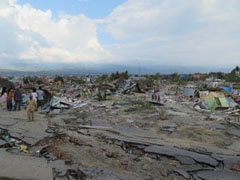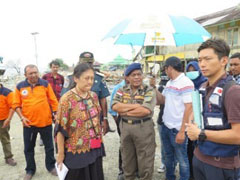December 12, 2018
The earthquake that occurred in September 2018 in Central Sulawesi Province, Indonesia, brought about large-scale landslides and tsunami that caused liquefaction in and around the provincial capital city of Pal, resulting in a catastrophic damage with more than 3,000 dead and missing. In response to the request from the Indonesian government, Japan immediately provided emergency assistance for the recovery and reconstruction after the disaster. This article introduces the trends in supporting the development of a reconstruction plan based on Japan's knowledge on post disaster management.

Large-scale landslide caused by liquefaction occurred in Balaroa district of Pal city.
On September 28, 2018, at about 18:02H (local time), a magnitude of 7.5 earthquake occurred with its epicenter at about 80 km to the north of the capital city of Pal in Central Sulawesi Province. The earthquake brought about large scale inland landslides and liquefaction caused by coastal tsunami which is extremely rare in the world, resulting in the serious damage with more than 2,101 dead, 4,438 affected, 1,373 missing, and approximately 70,000 houses destroyed. (Data as of November 20, 2018).
In response to the earthquake, JICA received a request for assistance from the National Development Planning Agency (BAPPENAS) for the development of a reconstruction plan. In an interview with BAPPENAS Minister Bambang held in conjunction with the World Bank IMF General Assembly on October 14, 2018, JICA's President Kitaoka received the formal request for assistance in developing the reconstruction plan.
In response to the request and to confirm the affected situation and assistance needed, JICA's Southeast Asia and Pacific Department dispatched to the sites, from October 15 to 23, 2018, a Survey Team composed of representatives from related departments and experts from universities as well as the Ministry of Land, Infrastructure, Transport and Tourism (Port and Airport Research Institute) of Japan. In the study, after a kick off discussion with the related organizations such as BAPPENAS in Jakarta, discussions with local governments and field surveys were conducted in the affected areas, and the Survey Team submitted a report to the Indonesian Government in Jakarta on the final day of the survey.
In the report, the Survey Team expressed its view that landslides by liquefaction in both inland and coastal areas could cause great damage in the occurrence of earthquakes. This view, based on the field survey results, data analysis, and expert knowledge, was highly appreciated by the Indonesian stakeholders, and was cited frequently at each subsequent meeting on the formulation of the reconstruction plan.
The reconstruction plan is a blueprint, so to speak, that shows the basic policy regarding recovery and reconstruction to actual project implementing organizations with whom BAPPENAS shall coordinate. The relevant ministries such as the Ministry of Public Works and the local governments shall formulate and carry out their own implementation plans based on this reconstruction plan. Therefore, in the reconstruction plan, it is very important that a policy based on the concept of "Build Back Better" is established on the belief that "the same damage will never be repeated."

Study team receiving an explanation from the governor of Donggala Prefecture during a site visit to the pantloan port damaged by the tsunami.
Furthermore, the key point of this reconstruction plan is how to assess the disaster risk caused by the liquefaction phenomena, which is extremely rare in the world, and how to connect it to actual countermeasures. In particular, it is indispensable that the fundamental policy, which is difficult to change once decided such as land use regulations, should be clearly stated in the reconstruction plan.
Therefore, JICA's experts working locally and consultants employed for the surveys played the central role in supporting the formulation of reconstruction plans in close consultation with the Indonesian Government. Regarding disaster risk assessment that was particularly a key point, JICA conducted ground surveys in the affected and candidate areas for relocation, and classified the results as "Draft Disaster Prone Zone" (Zona: Rawan Bencana: ZRB), which is a map classified into four (4) categories according to the level of disaster vulnerability, to assist the Indonesian Government in designating the ZRB. At the beginning of December, the "Recommendations for the Reconstruction Plan," including the draft ZRB, was compiled and submitted to BAPPENAS, and approved by the Vice President on December 12. 2018.
As a part of JICA's reconstruction support, the following development survey type of technical cooperation, namely, the "Project for Development of Regional Disaster Risk Resilience Plan in Central Sulawesi," is scheduled to start in January 2019. In this project, disaster risk assessment and hazard mapping, development support for spatial planning, promotion for infrastructure resilience, and recovery support for livelihood are to be implemented. The infrastructure reconstruction support through ODA Loan and Grant is in preparation.




scroll